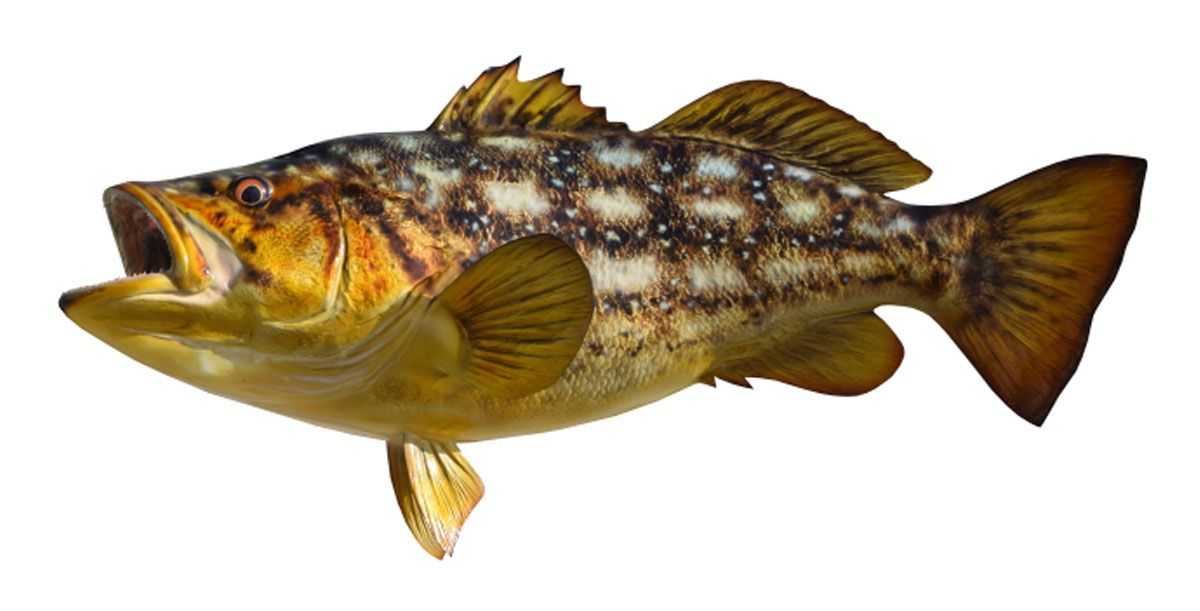Kelp Bass

Species Details
Paralabrax Clathratus
Serranidae
Perciformes
Onshore, Nearshore, Kelp Forests
4 - 14 lbs.
12" - 28"
Kelp Bass (Paralabrax clathratus) Fish Description
The Kelp Bass, or also known as the bull bass or calico bass is part of the marine-ray finned fish species.
Adult Kelp Bass have an olive green hue, while their adolescent counterparts are more towards a lighter brown. The upper part of the Kelp Bass’ head has pale yellow spots, whereas the body has black, white, and/or olive green marks. You can also find they have rows of rectangular white spots across their back. Their ventral areas are often cream or white. To help distinguish Kelp Bass from other marine bass is by their calico-like spotting on the underside of their belly. On the margin of the operculum of the Kelp Bass, a large spine is present. And from third to a fifth of their dorsal fins are all the same length.
Diet and Size
Kelp basses are carnivores and piscivores, but they can also eat non-insect arthropods. They commonly consume other fish, mollusks, crustaceans, other marine invertebrates, planktons, and algae. Their diet expands as they grow older. The Kelp Bass also shows cannibalistic tendencies. They feed heavier during spawning, from May through September, and feed lighter during the winter.
The Kelp Bass may reach up to 2.4 ft. and the maximum weight known is said to be 15 lbs.
Interesting Fact
The scientific name of the Kelp Bass is Paralabrax clathratus. The first half of that name, Paralabrax, is defined from the two Greek words as “near Labrax.” Labrax, a name of a European bass. And the second half, clathratus refers to the spottings or the markings on the sides of the fish.
Kelp Bass Fishing Techniques
Kelp Bass is considered to be a light tackle. They can be caught from breakwaters in sandbars, but you can also find them in kelp beds. Popular methods anglers use to catch them include: drifting, trolling, and still-fishing from fishing kayaks or anchored boats.
Lures that replicate the Kelp Bass’s diet would bode well, usage of various seafood such as anchovies, sardines, queenfish, crustaceans, and arthropods. But work especially better when colored brown or olive.
When it comes to choosing the rod, the faster ones work best. A 7 or 8 ft. saltwater rod would a baitcasting reel or spinning reel would be a good use. And considering you’ll most likely be catching these in the kelp forests, using a braided fishing line would be notably helpful so you can cut through the kelp if ever the fish gets tangled. And if the fish refuses to bite straight braid, a fluorocarbon leader could come in handy for fishing to keep the Kelp Bass away from the kelp and rocky structures.
For catching Kelp Bass, especially when fishing near kelp beds, is that immediately after they strike at a lure, they would run back towards the kelp beds in a diving pattern. Do your best in avoiding the chance to return to those kelp beds in preventative measures of getting your line tangled.
Habitat and Distribution
You can fish for Kelp Bass all year round in fisheries such as Los Angeles, Orange County, and San Diego. The most action you can get for these fish should be around the warmer months, between May and October, but scoring a large fish is still possible between November and April.
The Kelp Bass can also be caught around islands such as Catalina and San Clemente islands during their overnight fishing expeditions.
They commonly live in kelp forests they are found to be almost exclusive in this type of habitat. Younger Kelp Bass often stay amongst the kelp blades and seaweed in rocky areas, while Adults may stray further from the kelp forest to deeper and rockier habitats, as they are less susceptible to be predated on. Though adult Kelp Bass can be found in depths such as up to 200 ft., they are still found common in shallow waters going only as deep as 8 to 69 feet.







